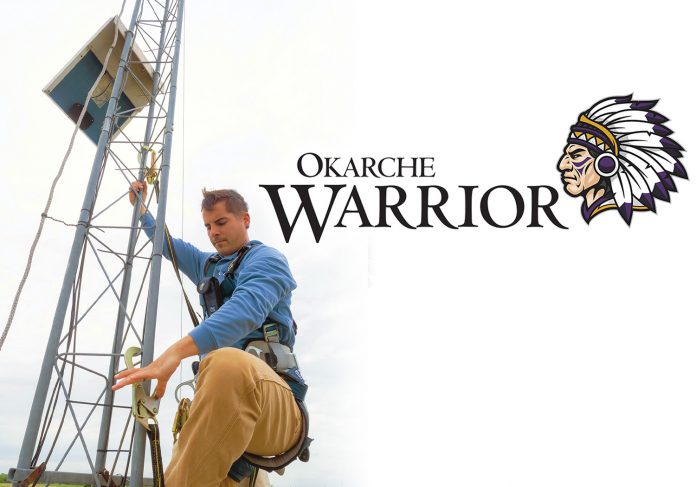
By Carol Mowdy Bond
Contributing Writer
Of Oklahoma’s Mesonet sites, there are two in Canadian County. And whether you know it or not, they’re helping you every single minute of every day in ways you may have never considered.
You can thank not only the state’s Mesonet system, but also the National Weather Center pros at the University of Oklahoma who interpret the Mesonet data, for information about wildfires, agriculture, power grids, protecting your economic assets, flood waters, weather information, educational support in schools, and other critically important information.
In Canadian County, there is one Mesonet site located just a bit north of the City of Yukon. And there’s a second one located in a field directly south of Fort Reno, which is co-located with the U.S. Department of Agriculture Agricultural Research Center Grazinglands Research Laboratory.
The City of Yukon’s public information officer and media specialist, Jenna Roberson, said, “While you may not hear us mention Mesonet directly, it has quite a large impact on our Emergency Management Department. The data gathered from Mesonet helps the National Weather Service predict significant weather events in advance, which gives both our emergency management team and our citizens invaluable time to prepare.”
Fire chief for the City of Piedmont, Andy Logan said, “The Piedmont Fire Department utilizes the Oklahoma Mesonet to monitor weather conditions year-round. The Mesonet provides information such as wind speed/direction, humidity, dew point, and has a live radar option. All this information, along with the OK-Fire and OK-First programs, allows trained fire department personnel to make operational decisions based on current and future weather conditions. Piedmont Fire Department currently has two personnel who have been trained by the Oklahoma Mesonet National Weather Service center in Norman and have been granted access to the Mesonet/NWS site to aid in monitoring weather conditions. These two individuals complete annual re-certification requirements to be able to maintain access to this program. In addition, these two personnel have access to the Mesonet/NWS live chat program that allows them to communicate weather information and conditions with other NWS, media, and emergency personnel, statewide, in a real-time format that provides information before it’s released to the local television and radio stations.”
Steve Liebl, the fire chief for the Town of Okarche, said, “If we’re out on a scene and we need weather information, we log into Mesonet and get real-time information. Mesonet has updated information on wind shift, change in the direction of wind, and things like that. It also gives us information for what will happen in the next 6, 12, to 24 hours. We use Mesonet to look up drought information and different things like that.”
The State Climatologist for Oklahoma, who works at the Oklahoma Climatological Survey, which operates the Oklahoma Mesonet, Gary McManus said, “The Oklahoma Mesonet is a series of 120 automated meteorological observation sites across the state, with at least one in each county. ‘Mesonet’ stands for ‘MESOscale NETwork.’ In meteorology, ‘mesoscale’ refers to weather events that range in size from about one mile to about 150 miles.
Mesoscale events last from several minutes to several hours. Therefore, mesoscale weather events are phenomena that might go undetected without densely spaced weather observations. Thunderstorms, wind gusts, heat bursts, and dry lines are examples of mesoscale events.”
A Mesonet site includes a 10-meter-tall tower with a grouping of meteorological measuring instruments that report their measurements to a central location. In Oklahoma, that location is the Oklahoma Climatology Survey, located in the National Weather Center at the University of Oklahoma. McManus said, “These instruments report their measurements to the central location every five minutes, 24 hours per day, every day of the year. The Mesonet measures the standard weather parameters, such as temperature, humidity, wind speeds, etc., along with more specialized agricultural measurements, like soil temperatures, soil moisture, and solar radiation. The Mesonet was commissioned January 1994.”
A few other common data that Mesonet sites collect includes barometric pressure, rainfall amounts, and wind direction. And Mesonet stations may also have cameras to capture images.
Mesonet sites are usually located in rural areas. These often unmanned sites are away from buildings or other structures, as well as trees or anything that might impact the measurements taken at the sites.
Emergency managers, police, fire, and public health officials all take advantage of what Oklahoma’s Mesonet data offers. As well, our state’s Mesonet has an OK-First program that has trained more than 120 public safety officials about weather decision making. Also, more than 1,000 fire managers have been trained about weather’s impact on wildfire suppression, prescribed burning, and smoke management. It’s estimated that $95 million has been saved by quick containment of wildfires in the region during a single wildfire outbreak.
State and federal agencies deal with transportation, water resource management, conservation, and severe weather and flood forecasting on a daily basis. Mesonet data is a big part of the information these agencies use. The energy industry also relies on Mesonet data for such situations as predicting electrical load peaks, and forecasting energy grid impacts from freezing rain or extreme heat.
Obviously in Oklahoma, keeping up with weather is critical for all of us. Not only does weather impact our safety, but it has an economic component to it that’s important statewide. When homes, vehicles, businesses, or agricultural fields and structures and animals and machinery are impacted by weather, the financial toll can be monumental.
McManus said it impacts our economy “on the individual scale all the way up to the statewide scale. The Mesonet helps save lives as well as millions of dollars each year through its ability to aid weather forecasters, emergency managers, energy companies, and agricultural producers, to name a few.”
Because the data is extensively used by Oklahoma’s media, from small town newspapers to major television stations, Mesonet provides Oklahoma’s over 1.3 million households with daily weather forecasts and lifesaving severe weather information. As just one example, on May 24, 2011, an EF5 tornado struck Canadian County, and took nine lives, and injured another 181 people. That storm produced the highest wind gust ever in Oklahoma, at 151 miles per hour. The El Reno Mesonet site instruments recorded the information.

Unfortunately, the deadly tornado damaged the El Reno Mesonet site instruments.
McManus said, “Much of Oklahoma’s weather occurs at time frames and scales small enough to be missed by the federal observation systems. The Mesonet stations are used extensively by meteorologists to track severe weather, and winter weather, as well as observe more diverse hazards like heat danger. Emergency managers across the state are also trained by Mesonet personnel in the use of Mesonet data, as well as other meteorological tools, such as radar, to keep citizens in their counties safe. Local firefighters are also trained to interpret the Mesonet data to track fires in order to protect lives and property, as well as the lives of their own firefighting personnel and equipment.”
Agriculture is a main focal point for Mesonet. And Oklahoma’s Mesonet is a joint operation between the University of Oklahoma and Oklahoma State University. For agricultural purposes, McManus said, “Agricultural applications of the Mesonet include improved insect and disease advisories, spraying recommendations, irrigation scheduling, frost protection, planting and harvesting recommendations and prescribed burn advisories. Agriculture is such a large Oklahoma industry that any increase in efficiency from more accurate environmental information can translate into several million dollars in statewide savings each year. The Mesonet also employs a Mesonet Agricultural Coordinator from the ranks of Oklahoma Cooperative Extension service out of OSU.”
Mesonet data is the key to monitoring drought conditions in the state, monitoring rainfall and soil moisture data. As a result, Oklahoma received $1 billion in federal aid to Oklahomans suffering from drought and its impact.
As well, over 300 state teachers have been trained in Mesonet, in order to enhance science and math curricula. And hundreds of students have attended meteorology summer camps. Last but not least, Mesonet data is a key to advancing the understanding of atmosphere in university research projects on a global scale.
To connect with Oklahoma’s Mesonet, go online to mesonet.org, and on Facebook to Oklahoma Mesonet.





